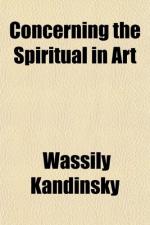[Footnote: Much theory and practice have been devoted to this question. People have sought to paint in counterpoint. Also unmusical children have been successfully helped to play the piano by quoting a parallel in colour (e.g., of flowers). On these lines Frau A. Sacharjin-Unkowsky has worked for several years and has evolved a method of “so describing sounds by natural colours, and colours by natural sounds, that colour could be heard and sound seen.” The system has proved successful for several years both in the inventor’s own school and the Conservatoire at St. Petersburg. Finally Scriabin, on more spiritual lines, has paralleled sound and colours in a chart not unlike that of Frau Unkowsky. In “Prometheus” he has given convincing proof of his theories. (His chart appeared in “Musik,” Moscow, 1911, No. 9.)]
[Footnote: The converse question, i.e. the colour of sound, was touched upon by Mallarme and systematized by his disciple Rene Ghil, whose book, Traite du Verbe, gives the rules for “l’instrumentation verbale.”—M.T.H.S.]
The explanation by association will not suffice us in many, and the most important cases. Those who have heard of chromotherapy will know that coloured light can exercise very definite influences on the whole body. Attempts have been made with different colours in the treatment of various nervous ailments. They have shown that red light stimulates and excites the heart, while blue light can cause temporary paralysis. But when the experiments come to be tried on animals and even plants, the association theory falls to the ground. So one is bound to admit that the question is at present unexplored, but that colour can exercise enormous influence over the body as a physical organism.
No more sufficient, in the psychic sphere, is the theory of association. Generally speaking, colour is a power which directly influences the soul. Colour is the keyboard, the eyes are the hammers, the soul is the piano with many strings. The artist is the hand which plays, touching one key or another, to cause vibrations in the soul.
It is evident therefore that colour harmony must rest only on A corresponding vibration in the human soul; and this is one of the guiding principles of the inner need.
[Footnote: The phrase “inner need” (innere Notwendigkeit) means primarily the impulse felt by the artist for spiritual expression. Kandinsky is apt, however, to use the phrase sometimes to mean not only the hunger for spiritual expression, but also the actual expression itself.—M.T.H.S.]
VI. THE LANGUAGE OF FORM AND COLOUR
The man that hath no music in himself, Nor is not mov’d with concord of sweet sounds, Is fit for treasons, stratagems, and spoils; The motions of his spirit are dull as night, And his affections dark as Erebus: Let no such man be trusted. Mark the music. (The Merchant of Venice, Act v, Scene I.)




